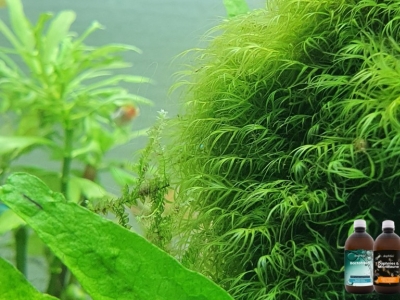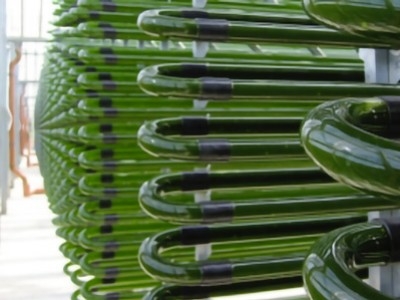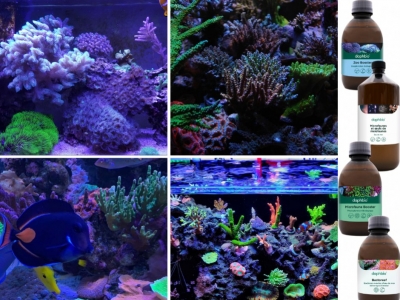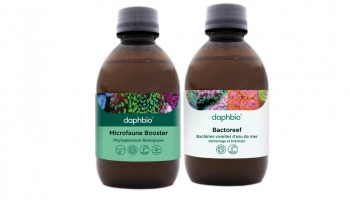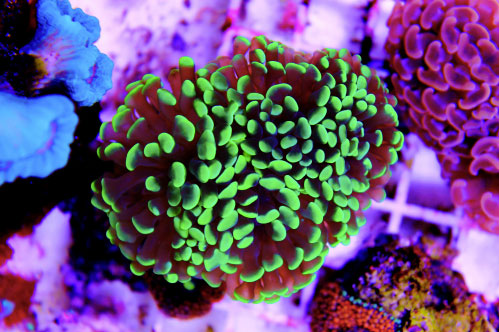Week 1
Products to use: Bactoreef, Microfauna Booster, Live Microfauna and Mesofauna, Instant Ocean sea salt. Protocol for the starter kit: Fill the aquarium with water and Instant Ocean salt from Aquarium Systems, start with a salinity of 1020-1024 and a temperature of 28-29 °C to stimulate bacterial growth. Gradually increase the salinity to a maximum of 1028 by the third week. The light remains off until the third week, but you can turn it on for a few hours per day to work in your aquarium or observe its development. Even if there are no stones yet, working on the water is crucial and you can start adding your products. Overdose the products Bactoreef and Microfauna Booster: double or triple the dosage indicated on the bottles for six days, so that cloudy or milky water results = bacterial bloom. After one week, pour out the bottle with the live microfauna and the eggs of the meiofauna. Now stones can be put in. Our living bacteria are shy of light. They penetrate the inside of the stones and make them their habitat. The skimmer is switched off.
Week 2
Products to use: Bactoreef, Microfauna Booster. Protocol: Continue to add Bactoreef and Microfauna Booster to your tank, but go to a normal dosage. The light as well as the skimmer are always switched off. The nitrate level is at its highest and gradually decreases with the addition of the products. The nitrites have already disappeared after the first few days. In contrast to freshwater aquariums, marine and reef aquariums always contain nitrites (in small amounts). They do not impair a successful start. Their presence is a prerequisite for the balance of the aquarium. The salt content can be increased.
Week 3
Products to use: Bactoreef, Microfauna Booster. Protocol: Continue to add Bactoreef and Microfauna Booster to your tank, but switch to a normal dosage according to the instructions on the bottles. The skimmer is still switched off. The cycling of the aquarium begins; the nitrate level will gradually continue to drop. You can start to light it for two to three hours a day. Allow the biofilm (milky yellow thin layer or fibres essential for microfauna development and coral adhesion) to grow throughout the aquarium.
Week 4 Products to be used: Bactoreef, Microfauna Booster. Protocol: Continue adding Bactoreef and Microfaune Booster, at normal dosage. The skimmer is always turned off. Light for 2 to 3 hours per day. Lower the temperature to 24°. One or more soft corals can be added. They will be your beta-test corals. Add a variety of snails. Make sure they are alive (there is a high mortality rate in pet shops for detritus feeders). Even if you can't see it with the naked eye, your aquarium is full of micro-particles and micro-algae which they will feed on. They will also participate in the continuity of the cycle and perpetuate it. The soft corals will also continue the cycle. Week 5 Products to use: Bactoreef, Microfauna Booster. Protocol: Continue adding Bactoreef and Microfauna Booster at normal dosage. Start lighting and skimming your aquarium for a few hours a day. With lighting, algae can appear. To limit this, reduce the intensity of the blue and red LEDs. These colour spectrums are very favourable to the development of algae and cyanobacteria. The growth of algae can also be favoured by certain stones that contain minerals, silicates and metals and heavy metals such as synthetic stones. We recommend our MarcoRocks stones, which are cycled and started, and free of pests. The detritivores introduced in week 3 are there to eat the algae, but if the algae are too long, they will leave them. If they have become too large, brush them off.
Week 6 Products to be used: Bactoreef, Microfauna Booster. Protocol: The aquarium is cycled, the microfauna appears between the end of the 1st month and the end of the 2nd month. Depending on the aquarium, the microfauna takes more or less time to develop. We do not explain this difference in time; it will develop at the pace it chooses. You can start to populate gradually. Be careful not to overfeed your occupants. Feed a very small meal once a day. It should be consumed in less than 2 minutes. Your aquarium is now on its way to success. Our other tips Salt: for the start of the aquarium, we recommend a non enriched salt, like Instant Ocean salt. Filtration: We recommend not to filter the water through a perlon or micron bag during the first 8 months of the aquarium's life. Bacteria must take possession of the aquarium and circulate everywhere, they must not be confined. Minerals: the addition of magnesium and calcium is not necessary for the first few months. If minerals must be added, they should only be added if they are completely consumed by the corals. If not, the addition of minerals can cause problems and will benefit algae and cyanobacteria. Sand: We recommend sand that is not enriched and not necessarily live. We prefer to avoid crushed coral sand. Sand without NO₃, PO₄ or silicates is essential. Bare bottom: The bare bottom trend is becoming more and more widespread. It offers significant advantages, although in this context, microfauna develops more difficult. Since the writing of this article and due to the problems in the supply of stones, but also the poor quality of the products on the market, we have imported MarcoRocks stones. We and our European testers have been testing them for 3 years. Today, we can say that there is no better product for reef and saltwater aquarium keeping. We highly recommend them for starting or restarting an aquarium, but also for your decants or refuges. We offer MarcoRocks for sale. Already cycled and started in our laboratory, all you have to do is place them in your aquarium.

 04 22 44 22 71
04 22 44 22 71













